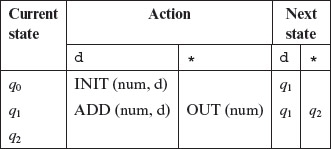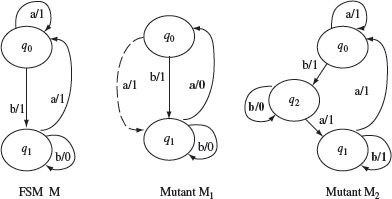5
Test Generation from Finite State Models
CONTENTS
The purpose of this chapter is to introduce techniques for the generation of test data from finite state models of software designs. A fault model and three test generation techniques are presented. The test generation techniques presented are the W-method, the Unique Input/Output method, and the Wp-method.
5.1 Software Design and Testing
Development of most software systems includes a design phase. In this phase the requirements serve as the basis for a design of the application to be developed. The design itself can be represented using one or more notations. Finite state machines (FSM), statecharts, and Petri nets are three design notations used in software design.
A simplified software development process is shown in Figure 5.1. Requirements analysis and design is a step that ideally follows requirements gathering. The end result of the design step is a design artifact that expresses a high-level application architecture and interactions amongst low-level application components. The design is usually expressed using a variety of notations such as those embodied in the UML design language. For example, UML statecharts are used to represent the design of the real-time portion of the application, and UML sequence diagrams are used to show the interactions between various application components.
Tests can be generated directly from formal expressions of software designs. Such tests can be used to test an implementation against its design.
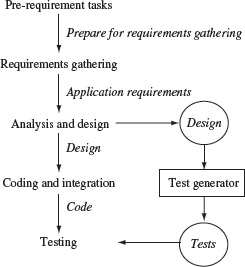
Figure 5.1 Design and test generation in a software development process. A design is an artifact generated in the Analysis and Design phase. This artifact becomes an input to the Test Generator algorithm that generates tests for input to the code during testing.
The design is often subjected to test prior to its input to the coding step. Simulation tools are used to check if the state transitions depicted in the statecharts do conform to the application requirements. Once the design has passed the test, it serves as an input to the coding step. Once the individual modules of the application have been coded, successfully tested, and debugged, they are integrated into an application and another test step is executed. This test step is known by various names such as system test and design verification test. In any case, the test cases against which the application is run can be derived from a variety of sources, design being one.
In this chapter, we show how a design can serve as source of tests that are used to test the application itself. As shown in Figure 5.1, the design generated at the end of the analysis and design phase serves as an input to a test generation procedure. This test generation procedure generates a number of tests that serve as inputs to the code in the test phase. Note that though Figure 5.1 seems to imply that the test generation procedure is applied to the entire design, this is not necessarily true; tests can be generated using portions of the design.
Finite State Machines (FSMs) and Statecharts are two well-known formalisms for expression software designs. Both these formalisms are part of UML.
We introduce several test generation procedures to derive tests from FSMs. An FSM offers a simple way to model state-based behavior of applications. The statechart is a rich extension of the FSM and needs to be handled differently when used as an input to a test generation algorithm. The Petri net is a useful formalism to express concurrency and timing and leads to yet another set of algorithms for generating tests. All test generation methods described in this chapter can be automated, though only some have been integrated into commercial test tools.
There exist several algorithms that take an FSM and some attributes of its implementation as inputs to generate tests. Note that the FSM serves as a source for test generation and is not the item under test. It is the implementation of the FSM that is under test. Such an implementation is also known as Implementation Under Test and abbreviated as IUT. For example, an FSM may represent a model of a communication protocol while an IUT is its implementation. The tests generated by the algorithms introduced in this chapter are inputs to the IUT to determine if the IUT behavior conforms to the requirements.
The following methods are introduced in this chapter: the W-method, the transition tour method, the distinguishing sequence method, the unique input/output method, and the partial W-method. In Section 5.9, we compare the various methods introduced. Before proceeding to describe the test generation procedures, we introduce a fault model for FSMs, the characterization set of an FSM, and a procedure to generate this set. The characterization set is useful in understanding and implementing the test generation methods introduced subsequently.
5.2 Finite State Machines
Many devices used in daily life contain embedded computers. For example, an automobile has several embedded computers to perform various tasks, engine control being one example. Another example is a computer inside a toy for processing inputs and generating audible and visual responses. Such devices are also known as embedded systems. An embedded system can be as simple as a child’s musical keyboard or as complex as the flight controller in an aircraft. In any case, an embedded system contains one or more computers for processing inputs.
An embedded computer often receives inputs from its environment and responds with appropriate actions. While doing so, it moves from one state to another. The response of an embedded system to its inputs depends on its current state. It is this behavior of an embedded system in response to inputs that is often modeled by an FSM. Relatively simpler systems, such as protocols, are modeled using FSMs. More complex systems, such as the engine controller of an aircraft, are modeled using statecharts which can be considered as a generalization of FSMs. In this section, we focus on FSMs. The next example illustrates a simple model using an FSM.
An FSM captures the behavior of a software or a software-hardware system as a finite sequence of states and transitions among them. The behavior of the modeled system for a given sequence of inputs can be obtained by starting the machine in its initial state and applying the sequence. This activity is also known as simulating the FSM.
Example 5.1 Consider a traditional table lamp that has a three-way rotary switch. When the switch is turned to one of its positions, the lamp is in the OFF state. Moving the switch clockwise to the next position moves the lamp to an ON-DIM state. Moving the switch further clockwise moves the lamp to the ON-BRIGHT state. Finally, moving the switch clockwise one more time brings the lamp back to the OFF state. The switch serves as the input device that controls the state of the lamp. The change of lamp state in response to the switch position is often illustrated using a state diagram as in Figure 5.2(a).
Our lamp has three states OFF, ON_DIM, and ON_BRIGHT, and one input. Note that the lamp switch has three distinct positions, though from a lamp user’s perspective the switch can only be turned clockwise to its next position. Thus, “turning the switch one notch clockwise” is the only input. Suppose that the switch also can be moved counterclockwise. In this latter case, the lamp has two inputs one corresponding to the clockwise motion and the other to the counterclockwise motion. The number of distinct states of the lamp remains three but the state diagram is now as in Figure 5.2(b).

Figure 5.2 Change of lamp state in response to the movement of a switch. (a) Switch can only move one notch clockwise (CW). (b) Switch can move one notch clockwise and counterclockwise (CCW).
In the above example, we have modeled the table lamp in terms of its states, inputs, and transitions. In most practical embedded systems, the application of an input might cause the system to perform an action in addition to performing a state transition. The action might be as trivial as “do nothing” and simply move to another state, or a complex function might be executed. The next example illustrates one such system.
We assume that upon the application of an input, an FSM moves from its current state to its next state and generates some observable output. The output could be, for example, change of screen, change of file contents, a message sent on the network, etc.
Example 5.2 Consider a machine that takes a sequence of one or more unsigned decimal digits as input and converts the sequence to an equivalent integer. For example, if the sequence of digits input is 3, 2, and 1, then the output of the machine is 321. We assume that the end of the input digit sequence is indicated by the asterisk (*) character. We shall refer to this machine as the DIGDEC machine. The state diagram of DIGDEC is shown in Figure 5.3.
The DIGDEC machine can be in any one of three states. It begins its operation in state q0. Upon receiving the first digit, denoted by d in the figure, it invokes the function INIT to initialize variable num to d. In addition, the machine moves to state q1 after performing the INIT operation. In q1 DIGDEC can receive a digit or an end-of-input character which in our case is the asterisk. If it receives a digit, it updates num to 10 * num + d and remains in state q1. Upon receiving an asterisk the machine executes the OUT operation to output the current value of num and moves to state q2. Notice the double circle around state q2. Often, such a double circle is used to indicate a final state of an FSM.
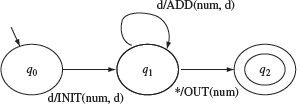
Figure 5.3 State diagram of the DIGDEC machine that converts sequence of decimal digits to an equivalent decimal number.
Historically, FSMs that do not associate any action with a transition are known as Moore machines. In Moore machines, actions depend on the current state. In contrast, FSMs that do associate actions with each state transition are known as Mealy machines. In this book, we are concerned with Mealy machines. In either case, an FSM consists of a finite set of states, a set of inputs, a start state, and a transition function which can be defined using the state diagram. In addition, a Mealy machine has a finite set of outputs. A formal definition of a Mealy machine follows.
FSMs are found in two types: Moore machines and Mealy machines. Moore machines do not associate actions with transitions while Mealy machines do.
Finite State Machine:
A finite state machine is a six tuple (X, Y, Q, q0, δ, O) where
- X is a finite set of input symbols also known as the input alphabet,
- Y is a finite set of output symbols also known as the output alphabet,
- Q is a finite set of states,
- q0 ϵ Q is the initial state,
- δ : Q × X → Q is a next-state or state transition function, and
- O : Q × X → Y is an output function.
In some variants of FSM more than one state could be specified as an initial state. Also, sometimes, it is convenient to add F ⊆ Q as a set of final or accepting states while specifying an FSM. The notion of accepting states is useful when an FSM is used as an automaton to recognize a language. Also note that the definition of the transition function δ implies that for any state qi in Q, there is at most one next state. Such FSMs are also known as deterministic FSMs. In this book, we are concerned only with deterministic FSMs. The state transition function for non-deterministic FSMs is defined as
which implies that such an FSM can have more than one possible transition out of a state on the same symbol. Non-deterministic FSMs are usually abbreviated as NFSM or NDFSM or simply as NFA for Non-deterministic Finite Automata.
Figure 5.4 Multiple labels for an edge connecting two states in an FSM.
The state transition and the output functions are extended to strings as follows. Let qi and qj be two, possibly same, states in Q and s = a1a2 . . . an a string over the input alphabet X of length n ≥ 0. δ(qi, s) = qj if δ(qi, a1) = qk and δ(qk, a2a3 . . . an) = qj. The output function is extended similarly. Thus, O(qi, s) = O(qi, a1) · O(δ(qi, a1), a2, a3, . . . , an). Also, δ(qi, ϵ) = qi and O(qi, ϵ) = ϵ.
A non-deterministic FSM (NDFSM) is one in which there are multiple outgoing transitions from state on the same input. Every NDFSM can be converted into an equivalent deterministic FSM.
Table 5.1 contains a formal description of the state and output functions of FSMs given in Figures 5.2 and 5.3. There is no output function for the table lamp. Note that the state transition function δ and the output function O can be defined by a state diagram as in Figures 5.2 and 5.3. Thus, for example, from Figure 5.2(a), we can derive δ(OFF, Turn_CW) = ON_DIM. As an example of the output function, we get O = INIT(num, 0) from Figure 5.3.
Table 5.1 Formal description of three FSMs from Figures 5.2 and 5.3.
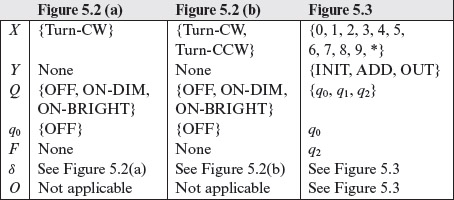
A state diagram is a directed graph that contains nodes representing states and edges representing state transitions and output functions. Each node is labeled with the state it represents. Each directed edge in a state diagram connects two states.
Each edge is labeled i/o where i denotes an input symbol that belongs to the input alphabet X and ο denotes an output symbol that belongs to the output alphabet Y . i is also known as the input portion of the edge and ο its output portion. Both i and ο might be abbreviations. As an example, the edge connecting states q0 and q1 in Figure 5.3 is labeled d/INIT(num, d) where d is an abbreviation for any digit from 0 to 9 and INIT(num, d) is an action.
The transition function of an FSM can be described using a state diagram or a table.
Multiple labels can also be assigned to an edge. For example, the label i1/o1 and i2/o2 associated with an edge that connects two states qi and qj implies that the FSM can move from qi to qj upon receiving either i1 or i2. Further, the FSM outputs o1 if it receives input i1 and outputs o2 if it receives o2. The transition and the output functions can also be defined in tabular form as explained in Section 5.2.2.
5.2.1 Excitation using an input sequence
In most practical situations, an implementation of an FSM is excited using a sequence of input symbols drawn from its input alphabet. For example, suppose that the table lamp whose state diagram is in Figure 5.2(b) is in state ON-BRIGHT and receives the input sequence r where
r = Turn_CCW Turn_CCW Turn_CW
Using the transition function in Figure 5.2(b), it is easy to verify that the sequence s will move the lamp from state ON_BRIGHT to state ON_DIM. This state transition can also be expressed as a sequence of transitions given below.
δ(ON_BRIGHT, Turn_CCW) = ON_DIM
δ(ON_DIM, Turn_CCW) = OFF
δ(OFF, Turn_CW) = ON_DIM
For brevity, we will use the notation δ(qk, z) = qj to indicate that an input sequence z of length one or more moves an FSM from state qk to state qj. Using this notation, we can write δ(ON_BRIGHT, r) = ON_DIM for the state diagram in Figure 5.2(b).
We will use a similar abbreviation for the output function O. For example, when excited by the input sequence 1001*, the DIGDEC machine ends up in state q2 after executing the following sequence of actions and state transitions:
O(q0, 1) = INIT(num,1), δ(q0, 1) = q1
O(q1, 0) = ADD(num,0), δ(q1, 0) = q1
O(q1, 0) = ADD(num,0), δ(q1, 0) = q1
O(q1, 1) = ADD(num,1), δ(q1, 1) = q1
O(q1, *) = OUT(num), δ(q1, *) = q2
Once again, for brevity, we will use the notation O(q, r) to indicate the action sequence executed by the FSM on input r when starting in state q. We also assume that a machine remains in its current state when excited with an empty sequence. Thus, δ(q, ϵ) = q. Using the abbreviation for state transitions, we can express the above action and transition sequence as follows

5.2.2 Tabular representation
A table is often used as an alternative to the state diagram to represent the state transition function δ and the output function O. The table consists of two sub-tables that consist of one or more columns each. The leftmost sub-table is the output or the action sub-table. The rows are labeled by the states of the FSM. The rightmost sub-table is the next state sub-table. The output sub-table, that corresponds to the output function O, is labeled by the elements of the input alphabet X. The next state sub-table, that corresponds to the transition function δ, is also labeled by elements of the input alphabet. The entries in the output sub-table indicate the actions taken by the FSM for a single input received in a given state. The entries in the next state sub-table indicate the state to which the FSM moves for a given input and in a given current state. The next example illustrates how the output and transition functions can be represented in a table.
The tabular representation of the transition function of an FSM is convenient for a computer implementation.
Example 5.3 The table given below shows how to represent functions δ and Ο for the DIGDEC machine. In this table, the column labeled “Action” defines the output function by listing the actions taken by the DIGDEC machine for various inputs. Sometimes, this column is also labeled as “Output” to indicate that the FSM generates an output symbol when it takes a transition. The column labeled “Next State” defines the transition function by listing the next state of the DIGDEC machine in response to an input. Empty entries in the table should be considered as undefined. However, in certain practical situations, the empty entries correspond to an “error” action. Note that in the table below we have used the abbreviation d for the ten digits, 0 through 9.
5.2.3 Properties of FSM
FSMs can be characterized by one or more of several properties. Some of the properties found useful in test generation are given below. We shall use these properties later while explaining algorithms for test generation.
An FSM is complete, or completely specified, if there is exactly one transition in each state for every element in the input alphabet.
Completely specified FSM: An FSM Μ is said to be completely specified if from each state in Μ there exists a transition for each input symbol. The machine described in Example 5.1 with state diagram in Figure 5.2(a) is completely specified as there is only one input symbol and each state has a transition corresponding to this input symbol. Similarly, the machine with state diagram shown in Figure 5.2(b) is also completely specified as each state has transitions corresponding to each of the two input symbols. The DIGDEC machine in Example 5.2 is not completely specified as state q0 does not have any transition corresponding to an asterisk and state q2 has no outgoing transitions.
An FSM is strongly connected if for every pair of states, say (q1, q2), there exists an input sequence that takes it from q1 to q2.
Strongly connected: An FSM Μ is considered strongly connected if for each pair of states (qi, qj), there exists an input sequence that takes Μ from state qi to qj. It is easy to verify that the machine in Example 5.1 is strongly connected. The DIGIDEC machine in Example 5.2 is not strongly connected as it is impossible to move from state q2 to q0, from q2 to q1, and from q1 to q0. In a strongly connected FSM, given some state qi ≠ q0, one can find an input sequence s ϵ X* that takes the machine from its initial state to qi. We therefore say that in a strongly connected FSM, every state is reachable from the initial state.
Two states in an FSM, say q1 and q2, are considered distinguishable if there exists at least one input sequence, say s, such that its application to the FSM in q1 and in q2 leads to different outputs. If no such s exists then q1 and q2 are considered equivalent.
V-equivalence: Let ![]() and
and ![]() be two FSMs. Let V denote a set of non-empty strings over the input alphabet X, i.e. V ⊆ X+. Let qi and qj, i ≠ j, be the states of machines M1 and M2, respectively. States qi and qj are considered V-equivalent if O1(qi, s) = O2(qj, s) for all s ϵ V. Stated differently, states qi and qj are considered V-equivalent if M1 and M2, when excited in states qi and qj, respectively, yield identical output sequences. States qi and qj are said to be equivalent if O1(qi, s) = O2(qj, s) for any set V. If qi and qj are not equivalent, then they are said to be distinguishable. This definition of equivalence also applies to states within a machine. Thus, machines M1 and M2 could be the same machine.
be two FSMs. Let V denote a set of non-empty strings over the input alphabet X, i.e. V ⊆ X+. Let qi and qj, i ≠ j, be the states of machines M1 and M2, respectively. States qi and qj are considered V-equivalent if O1(qi, s) = O2(qj, s) for all s ϵ V. Stated differently, states qi and qj are considered V-equivalent if M1 and M2, when excited in states qi and qj, respectively, yield identical output sequences. States qi and qj are said to be equivalent if O1(qi, s) = O2(qj, s) for any set V. If qi and qj are not equivalent, then they are said to be distinguishable. This definition of equivalence also applies to states within a machine. Thus, machines M1 and M2 could be the same machine.
Machine equivalence: Machines M1 and M2 are said to be equivalent if (a) for each state σ in M1, there exists a state σ′ in M2 such that σ and σ′ are equivalent and (b) for each state σ in M2, there exists a state σ′ in M1 such that σ and σ′ are equivalent. Machines that are not equivalent are considered distinguishable. If M1 and M2 are strongly connected, then they are equivalent if their respective initial states, ![]() are equivalent. We write M1 = M2 if machines M1 and M2 are equivalent and M1 ≠ M2 when they are distinguishable. Similarly, we write qi = qj when states qi and qj are equivalent and qi ≠ qj if they are distinguishable.
are equivalent. We write M1 = M2 if machines M1 and M2 are equivalent and M1 ≠ M2 when they are distinguishable. Similarly, we write qi = qj when states qi and qj are equivalent and qi ≠ qj if they are distinguishable.
Two FSMs are considered equivalent if they are indistinguishable. Such machines will generate identical outputs for each input sequence.
k-equivalence: Let ![]() and
and ![]() be two FSMs. States qi ϵ Q1 and qj ϵ Q2 are considered k-equivalent if when excited by any input of length k, yield identical output sequences. States that are not k-equivalent are considered k-distinguishable. Once again, M1 and M2 may be the same machines implying that k-distinguishability applies to any pair of states of an FSM. It is also easy to see that if two states are k-distinguishable for any k > 0, then they are also distinguishable for any n > k. If M1 and M2 are not k-distinguishable, then they are said to be k-equivalent.
be two FSMs. States qi ϵ Q1 and qj ϵ Q2 are considered k-equivalent if when excited by any input of length k, yield identical output sequences. States that are not k-equivalent are considered k-distinguishable. Once again, M1 and M2 may be the same machines implying that k-distinguishability applies to any pair of states of an FSM. It is also easy to see that if two states are k-distinguishable for any k > 0, then they are also distinguishable for any n > k. If M1 and M2 are not k-distinguishable, then they are said to be k-equivalent.
Two FSMs are k-equivalent if no string of length k or less over its input alphabet can distinguish them. FSMs that can be distinguished by strings of length greater than k are considered k-distinguishable.
Minimal machine: An FSM Μ is considered minimal if the number of states in Μ is less than or equal to any other FSM equivalent to M.
An FSM Μ is considered minimal if there exists no other FSM with fewer states and defines the same output function as M.
Example 5.4 Consider the DIGDEC machine in Figure 5.3. This machine is not completely specified. However, it is often the case that certain erroneous transitions are not indicated in the state diagram. A modified version of the DIGDEC machine appears in Figure 5.5. Here, we have labeled explicitly the error transitions by the output function ERROR( ).
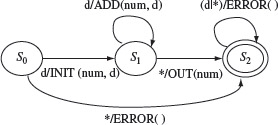
Figure 5.5 State diagram of a completely specified machine for converting a sequence of one or more decimal digits to their decimal number equivalent. d|* refers to digit or any other character.
5.3 Conformance Testing
The term conformance testing is used during the testing of communication protocols. An implementation of a communication protocol is said to conform to its specification if the implementation passes a collection of tests derived from the specification. In this chapter, we introduce techniques for generating tests to test an implementation for conformance testing of a protocol modeled as an FSM. Note that the term conformance testing applies equally well to the testing of any implementation that corresponds to its specification, regardless of whether or not the implementation is that of a communication protocol.
Testing an implementation against its design is also known as conformance testing.
Communication protocols are used in a variety of situations. For example, a common use of protocols is in public data networks. These networks use access protocols such as the X.25 which is a protocol standard for wide area network communications. The Alternating Bit Protocol (ABP) is another example of a protocol used in the connection-less transmission of messages from a transmitter to a receiver. Musical instruments such as synthesizers and electronic pianos use the MIDI (Musical Instrument Digital Interface) protocol to communicate amongst themselves and a computer. These are just a few examples of a large variety of communication protocols that exist and new ones are often under construction.
A protocol can be specified in a variety of ways. For example, it could be specified informally in textual form. It could also be specified more formally using an FSM, a visual notation such as a statechart, and using languages such as LOTOS (Language of Temporal Ordering Specification), Estelle, and SDL. In any case, the specification serves as a source for implementers and also for automatic code generators. As shown in Figure 5.6, an implementation of a protocol consists of a control portion and a data portion. The control portion captures the transitions in the protocol from one state to another. It is often modeled as an FSM. The data portion maintains information needed for the correct behavior. This includes counters and other variables that hold data. The data portion is modeled as a collection of program modules or segments.
FSM are used to specify a variety of systems- both physical and logical. Communication protocols can be specified using FSMs and can be the behavior of a robot.
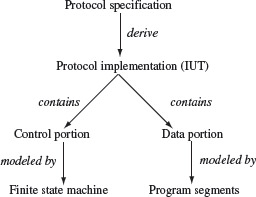
Figure 5.6 Relationship amongst protocol specification, implementation, and models.
Testing an implementation of a protocol involves testing both the control and data portions. The implementation under test is often referred to as IUT. In this chapter, we are concerned with testing the control portion of an IUT. Techniques for testing the data portion of the IUT are described in other chapters. Testing the control portion of an IUT requires the generation of test cases. As shown in Figure 5.7, the IUT is tested against the generated tests. Each test is a sequence of symbols that are input to the IUT. If the IUT behaves in accordance with the specification, as determined by an oracle, then its control portion is considered equivalent to the specification. Non-conformance usually implies that the IUT has an error that needs to be fixed. Such tests of an IUT are generally effective in revealing certain types of implementation errors discussed in Section 5.4.
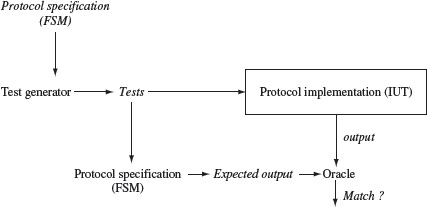
Figure 5.7 A simplified procedure for testing a protocol implementation against an FSM model. Italicized items represent data input to some procedure. Note that the model itself serves as data input to the test generator and as a procedure for deriving the expected output.
A typical computer program contains both control and data. An FSM captures only the control portion of the program (or its design). Thus, tests generated using an FSM test for the correctness of the control portion of the implementation.
A significant portion of this chapter is devoted to describing techniques for generating tests to test the control portion of an IUT corresponding to a formally specified design. The techniques described for testing IUTs modeled as FSMs are applicable to protocols and other requirements that can be modeled as FSMs. Most complex software systems are generally modeled using statecharts, and not FSMs. However, some of the test generation techniques described in this chapter are useful in generating tests from statecharts.
5.3.1 Reset inputs
The test methods described in this chapter often rely on the ability of a tester to reset the IUT so that it returns to its start state. Thus, given a set of test cases T = {t1, t2, . . . , tn}, a test proceeds as follows:
A reset input is needed to bring an implementation to its starting state. Such an input is useful in automated testing. A simple way to reset an implementation is to restart it. However, automated testing might be faster if instead of restarting an application, it can be brought to its initial state while the program resides in memory.
- Bring the IUT to its start state. Repeat the following steps for each test in Τ.
- Select the next test case from Τ and apply it to the IUT. Observe the behavior of the IUT and compare it against the expected behavior as shown in Figure 5.7. The IUT is said to have failed if it generates an output different from the expected output.
- Bring the IUT back to its start state by applying the reset input and repeat the above step but with the next test input.
It is usually assumed that the application of the reset input generates a null output. Thus, for the purpose of testing an IUT against its control specification FSM Μ = (X, Y, Q, q1, δ, O), the input and output alphabets are augmented as follows:
X = X ∪ {Re}
Y = Y ∪ {null}
where Re denotes the reset input and null the corresponding output.
While testing a software implementation against its design, a reset input might require executing the implementation from the beginning, i.e. restarting the implementation, manually or automatically via, for example, a script. However, in situations where the implementation causes side effects, such as writing to a file or sending a message over a network, bringing the implementation to its start state might be a non-trivial task if its behavior depends on the state of the environment. While testing continuously running programs, such as network servers, the application of a reset input does imply bringing the server to its initial state but not necessarily shutting it down and restarting.
Side effects might make it difficult to bring an IUT to its start state. Such side effects include change in the environment such as a database or the state of any connected hardware on which the behavior of the IUT depends.
The transitions corresponding to the reset input are generally not shown in the state diagram. In a sense, these are hidden transitions that are allowed during the execution of the implementation. When necessary, these transitions could be shown explicitly as in Figure 5.8.
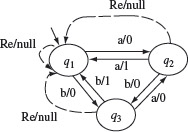
Figure 5.8 Transitions corresponding to reset (Re) inputs.
Example 5.5 Consider the test of an application that resides inside a microwave oven. Suppose that one test, say t1, corresponds to testing the “set clock time” functions. Another test, say t2, corresponds to the heating ability of the oven under “low power” setting. Finally, the third test t3 tests the ability of the oven under “high power” setting. In its start state, the oven has electrical power applied and is ready to receive commands from its keypad. We assume that the clock time setting is not a component of the start state. This implies that the current time on the clock, e.g. 1:15 pm or 2:09 am, does not have any effect on the state of the oven.
It seems obvious that the three tests mentioned above can be executed in any sequence. Further, once a test is completed and the oven application, and the oven, does not fail, the oven will be in its start state and hence no explicit reset input is required prior to executing the next test.
However, the scenario mentioned above might change after the application of, for example, t2, if there is an error in the application under test or in the hardware that receives control commands from the application under test. For example, the application of t2 is expected to start the oven’s heating process. However, due to some hardware or software error, this might not happen and the oven application might enter a loop waiting to receive a “task completed” confirmation signal from the hardware. In this case, tests t3 or t1 cannot be applied unless the oven control software and hardware are reset to their start state.
It is due to situations such as the one described in the previous example that require the availability of a reset input to bring the IUT under test to its start state. Bringing the IUT to its start state gets it ready to receive the next test input.
5.3.2 The testing problem
There are several ways to express the design of a system or a subsystem. FSM, statecharts, and Petri Nets are some of the formalisms to express various aspects of a design. Protocols, for example, are often expressed as FSMs. Software designs are expressed using statecharts. Petri nets are often used to express aspects of designs that relate to concurrency and timing. The design is used as a source for the generation of tests that are used subsequently to test the IUT for conformance to the design.
Let Μ be a formal representation of a design. As above, this could be an FSM, a statechart, or a Petri net. Other formalisms are possible too. Let R denote the requirements that led to M. R may be for a communication protocol, an embedded system such as the automobile engine or a heart pacemaker. Often, both R and Μ are used as the basis for the generation of tests and to determine the expected output as shown in Figure 5.7. In this chapter, we are concerned with the generation of tests using M.
Given an FSM and an IUT, the testing problem is to determine if the IUT is equivalent to the FSM. While in general this problem is undecidable, assumptions on the nature of faults in the IUT and the behavior of the IUT itself make the problem tractable.
The testing problem is to determine if the IUT is equivalent to M. For the FSM representation, equivalence was defined earlier. For other representations, equivalence is defined in terms of the input/output behavior of the IUT and M. As mentioned earlier, the protocol or design of interest might be implemented in hardware, software, or a combination of the two. Testing the IUT for equivalence against Μ requires executing it against a sequence of test inputs derived from Μ and comparing the observed behavior with the expected behavior as shown in Figure 5.7. Generation of tests from a formal representation of the design and their evaluation in terms of their fault detection ability is the key subject of this chapter.
5.4 A Fault Model
Given a set of requirements R, one often constructs a design from the requirements. An FSM is one possible representation of the design. Let Md be a design intended to meet the requirements in R. Sometimes, Md is referred to as a specification that guides the implementation. Md is implemented in hardware or software. Let Mi denote an implementation that is intended to meet the requirements in R and has been derived using Md. Note that, in practice, Mi is unlikely to be an exact analog of Md. In embedded real-time systems and communications protocols, it is often the case that Mi is a computer program that uses variables and operations not modeled in Md. Thus, one could consider Md as a finite state model of Mi.
The problem in testing is to determine whether or not Mi conforms to R. To do so, one tests Mi using a variety of inputs and checks for the correctness of the behavior of Mi with respect to R. The design Md can be useful in generating a set Τ of tests for Mi. Tests so generated are also known as black-box tests, because they have been generated with reference to Md and not Mi. Given T, one tests Mi against each test t ϵ Τ and compares the behavior of Mi with the expected behavior given by exciting Md in the initial state with test t.
Conformance testing, as presented in this chapter, is a black-box testing technique; tests are generated from the design and not the IUT.
In an ideal situation, one would like to ensure that any error in Mi is revealed by testing it against some test t ϵ Τ derived from Md. One reason why this is not feasible is that the number of possible implementations of a design Md is infinite. This gives rise to the possibility of a large variety of errors one could introduce in Mi. In the face of this reality, a fault model has been proposed. This fault model defines a small set of possible fault types that can occur in Mi. Given a fault model, the goal is to generate a test set Τ from a design Md. Any fault in Mi of the type in the fault model, is guaranteed to be revealed when tested against Τ.
A widely used fault model for FSMs is shown in Figure 5.9. This figure illustrates four fault categories.
- Operation error: Any error in the output generated upon a transition is an operation error. This is illustrated by machines Μ and M1 in Figure 5.9 where FSM M1 generates an output 0, instead of a 1, when symbol a is input in state q0. More formally, an operation error implies that for some state qi in Μ and some input symbol s, O(qi, s) is incorrect.
A fault model for testing using FSMs includes four types of errors: operation error, transfer error, extra state error, and missing state error. An operation error implies an incorrect output function. A transfer error implies an incorrect state transition function.
- Transfer error: Any error in the transition from one state to the next is a transition error. This is illustrated by machine M2 in Figure 5.9 where FSM M2 moves to state q1, instead of moving to q0 from q0 when symbol a is input. More formally, a transfer error implies that for some state qi in Μ and some input symbol s, δ(qi, x) is incorrect.
- Extra state error: An extra state may be introduced in the implementation. In Figure 5.9, machine M3 has q2 as the extra state when compared with the state set of machine M. However, an extra state may or may not be an error. For example, in Figure 5.10, machine Μ represents the correct design. Machines M1 and M2 have one extra state each. However, M1 is an erroneous design but M2 is not. This is because M2 is actually equivalent to Μ even though it has an extra state.
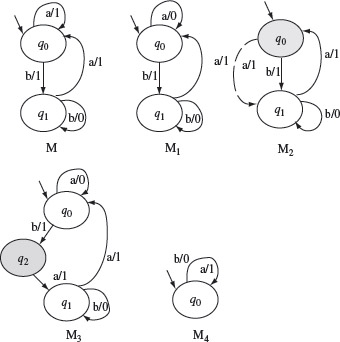
Figure 5.9 Machine Μ represents the correct design. Machines M1, M2, M3, and M4 each contain an error.
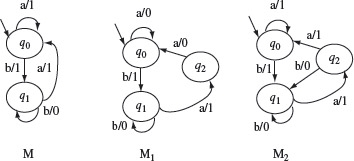
Figure 5.10 Machine Μ represents the correct design. Machines M1 and M2 each have an extra state. However, M1 is erroneous and M2 is equivalent to M.
A fault model aids in the assessment of the effectiveness of tests generated by techniques presented in this chapter.
- Missing state error: A missing state is another type of error. We note from Figure 5.9 that machine M4 has q1 missing when compared with machine M. Given that the machine representing the correct design is minimal and complete, a missing state implies an error in the IUT.
The above fault model is generally used to evaluate a method for generating tests from a given FSM. The faults indicated above are also known collectively as sequencing faults or sequencing errors. It may be noted that a given implementation could have more than one error of the same type. Other possibilities, such as two errors one each of a different type, also exist.
5.4.1 Mutants of FSMs
As mentioned earlier, given a design Md, one could construct many correct and incorrect implementations. Let I(Md) denote the set of all possible implementations of Md. In order to make I finite, we assume that any implementation in I(Md) differs from Md in known ways. One way to distinguish an implementation from its specification is through the use of mutants. A mutant of Md is an FSM obtained by introducing one or more errors one or more times. We assume that the errors introduced belong to the fault model described earlier. Using this method, we see in Figure 5.9 four mutants M1, M2, M3, and M4 of machine M. More complex mutants can also be obtained by introducing more than one error in a machine. Figure 5.11 shows two such mutants of machine Μ of Figure 5.9.
Figure 5.11 Two mutants of machine M. Mutant M1 is obtained by introducing into Μ one operation error in state q1 and one transfer error in state q0 for input a. Mutant M2 has been obtained by introducing an extra state q2 in machine Μ and an operation error in state q1, on input b.
A slight variation, say M1, of the correct design Μ is known as a mutant of M. Mutants are useful in assessing the adequacy of the generated tests. If M1 is not equivalent to Μ then at least one test case, say t, must cause M1 to behave differently than Μ in terms of the outputs generated. In such a situation M1 is considered distinguished from Μ by test t.
Note that a mutant may be equivalent to Md implying that the output behaviors of Md and the mutant are identical on all possible inputs. Given a test set T, we say that a mutant is distinguished from Md by a test t ϵ T, if the output sequence generated by the mutant is different from that generated by Md when excited with t in their respective initial states. In this case, we also say that Τ distinguishes the mutant.
Using the idea of mutation, one can construct a finite set of possible implementations of a given specification Md. Of course, this requires that some constraints are placed on the process of mutation, i.e. on how the errors are introduced. We caution the reader that the technique of testing software using program mutation is different from the use of mutation described here. This difference is discussed in Chapter 8. The next example illustrates how to obtain one set of possible implementations.
A first order mutant is obtain by making one change in an FSM. Higher order mutants are combinations of two or more first order mutants.
Example 5.6 Let Μ shown in Figure 5.12 denote the correct design. Suppose that we are allowed to introduce only one error at a time in M. This generates four mutants M1, M2, M3, and M4 shown in Figure 5.12 obtained by introducing an operation error. Considering that each state has two transitions, we get four additional mutants M5, M6, M7, and M8 by introducing the transfer error.
Figure 5.12 Eight first-order mutants of Μ generated by introducing operation and transfer errors. Mutants M1, M2, M3, and M4 are generated by introducing operation errors in M. Mutants M5, M6, M7, and M8 are generated by introducing transfer errors in M.
Introducing an additional state to create a mutant is more complex. First, we assume that only one extra state can be added to the FSM. However, there are several ways in which this state can interact with the existing states in the machine. This extra state can have two transitions that can be specified in 36 different ways depending on the tail state of the transition and the associated output function. We delegate to Exercise 5.10 the task of creating all the mutants of Μ by introducing an extra state.
Removing a state can be done in only two ways: remove q0 or remove q1. This generates two mutants. In general, this could be more complex when the number of states is greater than three. Removing a state will require the redirection of transitions and hence the number of mutants generated will be more than the number of states in the correct design.
Any non-empty test starting with symbol a distinguishes Μ from M1. Mutant M2 is distinguished from Μ by the input sequence ab. Note that when excited with ab, Μ outputs the string 11, whereas M2 outputs the string 10. Input ab also distinguishes M5 from M. The complete set of distinguishing inputs can be found using the W-method described in Section 5.6.
5.4.2 Fault coverage
One way to determine the “goodness” of a test set is to compute how many errors it reveals in a given implementation Mi. A test set that can reveal all errors in Mi is considered superior to one that fails to reveal one or more errors. Methods for the generation of test sets are often evaluated based on their fault coverage. The fault coverage of a test set is measured as a fraction between 0 and 1 and with respect to a given design specification. We give a formal definition of fault coverage in the following where the fault model presented earlier is assumed to generate the mutants.
Fault coverage is a measure of the goodness of a test set. It is defined as the ratio of the number of faults detected by a test set to the number of faults present in an IUT. Mutants can be used as a means to generate “faulty” designs.
Nt: Total number of first-order mutants of the machine Μ used for generating tests. This is also the same as |I(M)|.
Ne: Number of mutants that are equivalent to M.
Nf : Number of mutants that are distinguished by test set Τ generated using some test generation method. Recall that these are the faulty mutants as no input in Τ is able to distinguish these mutants.
Nl: Number of mutants that are not distinguished by Τ.
The fault coverage of a test suite Τ with respect to a design M, and an implementation set I(M), is denoted by FC(T, M) and computed as follows.
In Section 5.9, we will see how FC can be used to evaluate the goodness of various methods to generate tests from FSMs. Next, we introduce the characterization set, and its computation, useful in various methods for generating tests from FSMs.

